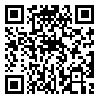Volume 6, Issue 1 (2017)
JFST 2017, 6(1): 89-100 |
Back to browse issues page
Download citation:
BibTeX | RIS | EndNote | Medlars | ProCite | Reference Manager | RefWorks
Send citation to:



BibTeX | RIS | EndNote | Medlars | ProCite | Reference Manager | RefWorks
Send citation to:
Moradi P, Jafaryan H, Soltani M, Gholipour Kanani H, Sahandi J. Effect of fermented Daphnia meal with Bacillus probiotic in-feed of Rainbow trout (Oncorhynchus mykiss) larvae on growth performance and carcass composition. JFST 2017; 6 (1) :89-100
URL: http://jfst.modares.ac.ir/article-6-3125-en.html
URL: http://jfst.modares.ac.ir/article-6-3125-en.html
1- Faculty of Natural Resource, Gonbad Kavous University
2- Faculty of Veterinary, University of Tehran
3- Department of Marine biology, Faculty of Marine Life Science, Ocean University of China
2- Faculty of Veterinary, University of Tehran
3- Department of Marine biology, Faculty of Marine Life Science, Ocean University of China
Abstract: (7861 Views)
In a completely randomized experiment, the effect of Daphnia magna meal on growth performance and carcass composition of rainbow trout (Oncorhynchus mykiss) larvae (body weight 0.538±0.197 g) was evaluated for a period of 60 days. Five diets with the same protein content (crude protein 52.70%) were prepared, including two diets containing fermented daphnia meal T1 (20%), T2 (30%), two diets containing raw meal T3 (20%) and T4 (30%), and a basal diet without daphnia meal as the control. The bacterial species used for fermenting included five commercial probiotic species. Fermented daphnia meal brought about significantly higher growth and the lowest feed conversion ratios, viz. T1 (1.27 ± 0.35) and T2 (1.31 ± 0.46), in comparison with T3 (1.38 ± 0.37), T4 (1.41 ± 0.42) and the control (1.84 ± 0.69) (p<0.05). The result of carcass composition analyzes showed that the highest protein percentage (68.23 ± 0.48%) was in T2 and the highest percentage of fat and energy (11.26 ± 0.50% , 4761.63 ±48.88 Cal g-1) were in T4 (p<0.05). The overall results of this experiment indicated that daphnia could be considered as a suitable partial protein source in rainbow trout larval feed.
Article Type: Research Article |
Subject:
Fis nutrition
Received: 2014/06/23 | Published: 2017/05/22
Received: 2014/06/23 | Published: 2017/05/22
| Rights and permissions | |
 |
This work is licensed under a Creative Commons Attribution-NonCommercial 4.0 International License. |








